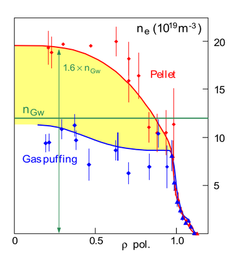Pellet Injection tasks
1. Particle fuelling:
Studies for future fusion power plants based on the tokamak principle show that at the high central pressure required for efficient operation, the temperature in the core plasma would exceed the optimum value for D-T fusion if the device is operated with conventional gas puffing only.

When the density is increased using an increasing amount of gas, density profiles become more and more flat and are restricted to values below an empirical limit referred to as the “Greenwald density limit “. The limit is considered to be a limit of the plasma edge density and should not impose a restriction to the core density.
Pellets made from frozen solid fuel, injected deep into the plasma in present devices, have shown to be a prime candidate to improve core fuelling. Appropriate pellets injection with sufficient size and speed into the plasma with a reasonable repetition rate has been proven operational at densities not
accessible by gas puffing.
2. ELM control:
Edge Localized Modes – ELMs – are plasma instabilities frequently evolving when operating the plasma in a regime with high energy confinement, called H-mode.
The operational regime foreseen for ITER, called “baseline H-mode” is expected to develop spontaneous ELMs at a frequency too low. Such a low frequency could result in strong energy bursts from the plasma. Hence, controlling the ELM frequency is an important task for the development of high performance plasma scenarios.

ELM control requirements in ITER cover the limitation and mitigation of the large heat fluxes to the divertor and the first wall expected during ELMs for H-mode operational scenarios at
high plasma current. Also the sustainment of a minimum ELM frequency is required when operating with a tungsten (W) divertor, to expel this metallic impurity from the plasma edge before it diffuses to the plasma core and causes excessive radiative losses.
Pellets have been found to trigger such ELMs on purpose and hence can be applied for controlling the ELM frequency and size. Since its first demonstration at ASDEX Upgrade, pellet ELM pacing is considered as one of the most suitable tools to achieve these tasks in ITER. ELM triggering is believed to be occurring due to the local perturbation caused by the evaporation of the pellet inside the plasma.

